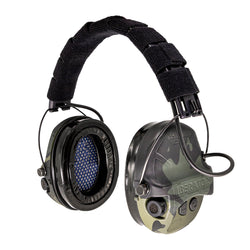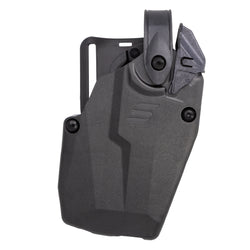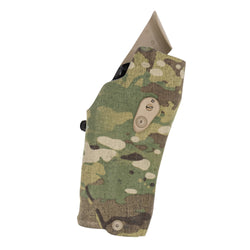Overlanders enjoy traveling off the beaten path to get away from the world. It seems odd they would need to be concerned about the actions of others when exploring the wilderness, but criminals exist in civilization, and far from it.
Crime is prevented with vigilance, and it is addressed properly when law enforcement is around, but in the backcountry, the unknown terrain can hide threats, and help can be miles away.
The overlander and their party must provide their own security. Should you decide to venture into the wilderness, follow these guidelines to improve your overall safety and make sure your trip goes as planned.
Maintaining OPSEC in Town
You never want to invite trouble to your home. When overlanding, you carry your home with you. While traveling, you will encounter friendly strangers as you gas up, purchase provisions, pick up supplies, and frequent more populated areas.

Your vehicle may attract attention, and strangers may want to interact with you. You’ll be asked where you’re from, where you’re going, who you’re traveling with, and other questions they don’t need the answers to.
You decide whether or not to volunteer information to these unknowns. A simple “I’d rather not say” is all you need to offer up. You owe no one your politeness. Providing too much information helps others fill in the pieces of how they will take advantage of you.
Wagon Wheel Concept
If you’re traveling with a group of vehicles, you can position them in camp to your security advantage. Much like a wagon wheel with a central hub and spokes, you can set up your camp in the center and back your vehicles in with the headlights facing outward.

If you are traveling solo, you can angle your vehicle with the headlights facing the most likely entrance to your camp. The auxiliary lights your vehicle likely has are both bright enough to illuminate the trail and temporarily bleach the eyesight of anyone coming in.

Positioning your vehicle facing out also helps you drive out of your campsite in the dark rather than backing out of a spot into the unknown.
If you are hauling a trailer, there’s no need to keep it connected to your vehicle once you reach camp. Maintain your mobility by freeing up the tow vehicle if you have to leave in a hurry.

Discreet Preparedness
You’ve likely witnessed a well-equipped overland vehicle in your neighborhood grocery store parking lot or rolling down the freeway. Roof rack equipped with a Hi-Lift Jack and shovel, front-end protected by an oversized tubular grill guard, “widdle wadder” hanging off the rear cargo door.
When there isn’t room to carry equipment inside the vehicle, it makes sense to attach it to the exterior. This carry method is anything but discreet, and it sends out a signal to onlookers the same way MOLON LABE and NRA stickers indicate there is a good chance firearms are carried inside this vehicle.

Rather than carrying equipment out in the open, find ways to keep it concealed. Pelican cases can be mounted to rooftops along with Thule or Yakima storage boxes. Pick-up drivers can use bed-mounted tool boxes or bed storage boxes like those from Decked. Center console and storage box replacement cores with greater security can be added to hold items that need the most protection.
Keep in mind, all of these storage solutions come at a price, usually a high one, but replacing stolen gear can be equally expensive or more so.
Maintain Communication
Depending on where you are and what mobile phone you’re using, you may or may not have service. Plan on your phone going down.
If traveling with multiple vehicles, inexpensive short-wave radios make sense for vehicle-to-vehicle communication. Longer whip antenna units like those from Iron Spear Outfitters or those meant for rooftop use will help extend the range of your devices.

Satellite communication devices like the Garmin In Reach sync with your mobile phone and allow you to text message anywhere in the world as long as you have a view of the sky. These devices can be used with a communications window with loved ones anywhere in the world.
Should you need wifi access for whatever reason, Starlink is an incredible option that will provide it with relatively easy setup. As with all electronic devices, protect them in transit from accidental breakage and have the means to keep them powered up with battery packs and solar devices.
Security-minded S.O.P.s.

Distance is your friend when dealing with any threat. If you’re overlanding, you want to put distance between you and the city or the source of your daily stress.
Distance is determined by fuel and should a threat, man-made or natural, present itself, putting miles between you and the threat is the best course of action. This is accomplished by adhering to the half-tank habit and filling up when your vehicle reaches half empty. Since there are no gas stations in the wild, carry jerry cans to top off when you can.

Another habit to adopt is having a singular place where your keys can be found when your vehicle is parked. Instead of putting them in your upturned hat one day, clipped to your pack another, and resting on your dashboard the next, pick one place that everyone in your group is aware of where they can find them when they are needed.
Similar to staging keys consistently, you should also stage emergency flashlights, medical kits, and recovery gear.

Overlanding lets you escape reality, but there are some considerations you should never ignore. That said, don’t let the possibility of a security threat overshadow where you are and what you experience.
More than likely, you will never encounter significant trouble on the trail aside from typical flat tires, stuck vehicles, and dead batteries. Preparing for those is a topic for another day.
Even if the odds are low that you’ll ever need to fall back on your training and gear, you’ll be thankful you took the time to prepare. Getting yourself and your vehicle ready for a worst-case scenario is worth it if one ever finds its way into your camp.









